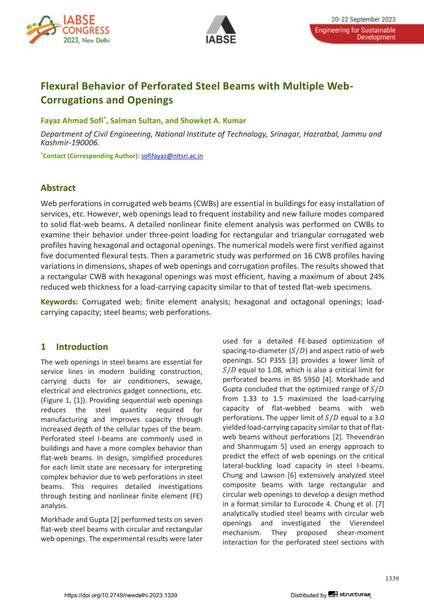Flexural Behavior of Perforated Steel Beams with Multiple Web-Corrugations and Openings

|
|
|||||||||||
Détails bibliographiques
| Auteur(s): |
Fayaz Ahmad Sofi
(Department of Civil Engineering, National Institute of Technology, Srinagar, Hazratbal, Jammu and Kashmir-190006.)
Salman Sultan (Department of Civil Engineering, National Institute of Technology, Srinagar, Hazratbal, Jammu and Kashmir-190006.) Showket A. Kumar (Department of Civil Engineering, National Institute of Technology, Srinagar, Hazratbal, Jammu and Kashmir-190006.) |
||||
|---|---|---|---|---|---|
| Médium: | papier de conférence | ||||
| Langue(s): | anglais | ||||
| Conférence: | IABSE Congress: Engineering for Sustainable Development, New Delhi, India, 20-22 September 2023 | ||||
| Publié dans: | IABSE Congress New Delhi 2023 | ||||
|
|||||
| Page(s): | 1339-1347 | ||||
| Nombre total de pages (du PDF): | 9 | ||||
| DOI: | 10.2749/newdelhi.2023.1339 | ||||
| Abstrait: |
Web perforations in corrugated web beams {CWBs) are essential in buildings for easy installation of services, etc. However, web openings lead to frequent instability and new failure modes compared to solid flat-web beams. A detailed nonlinear finite element analysis was performed on CWBs to examine their behavior under three-point loading for rectangular and triangular corrugated web profiles having hexagonal and octagonal openings. The numerical models were first verified against five documented flexural tests. Then a parametric study was performed on 16 CWB profiles having variations in dimensions, shapes of web openings and corrugation profiles. The results showed that a rectangular CWB with hexagonal openings was most efficient, having a maximum of about 24% reduced web thickness for a load-carrying capacity similar to that of tested flat-web specimens. |
||||
